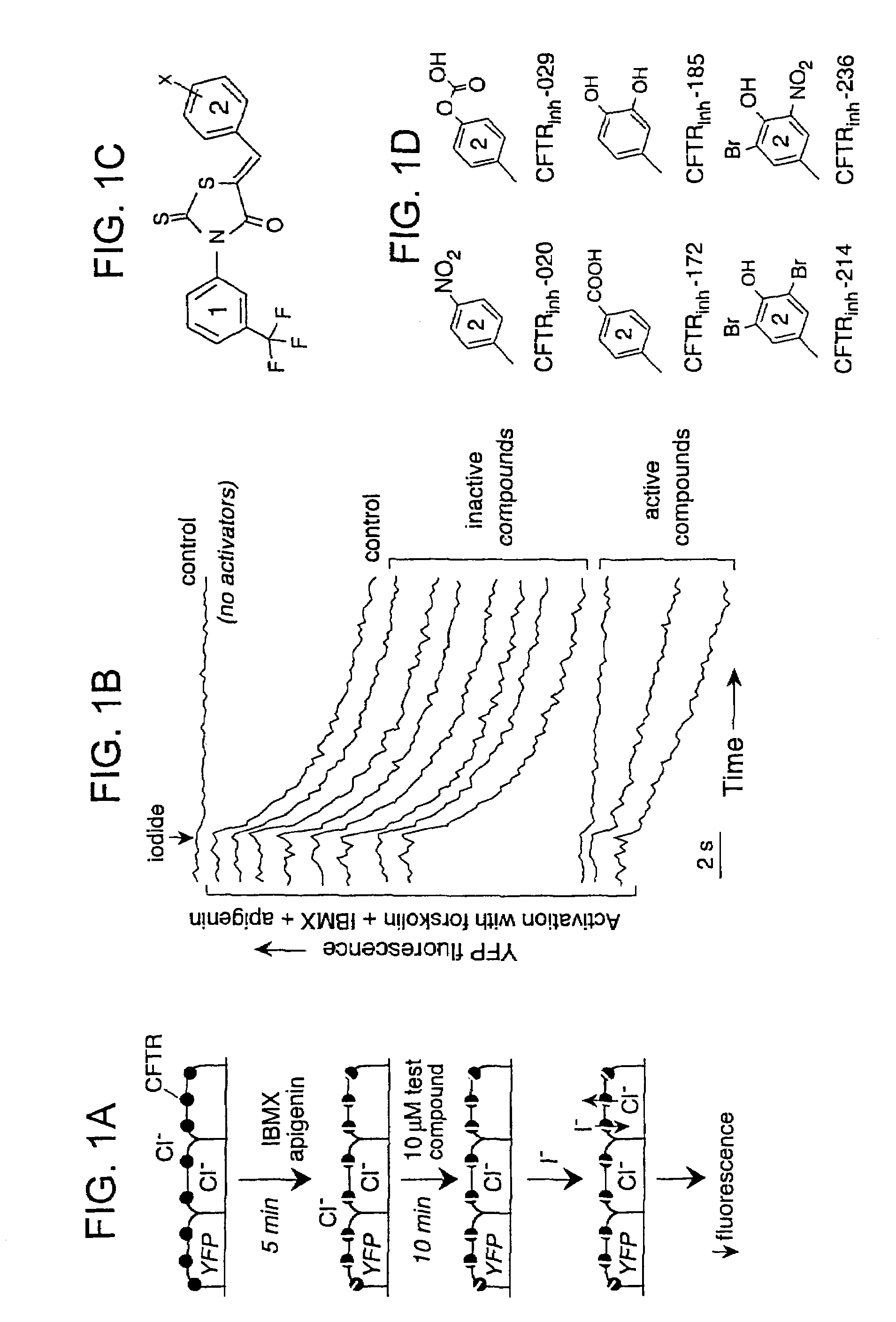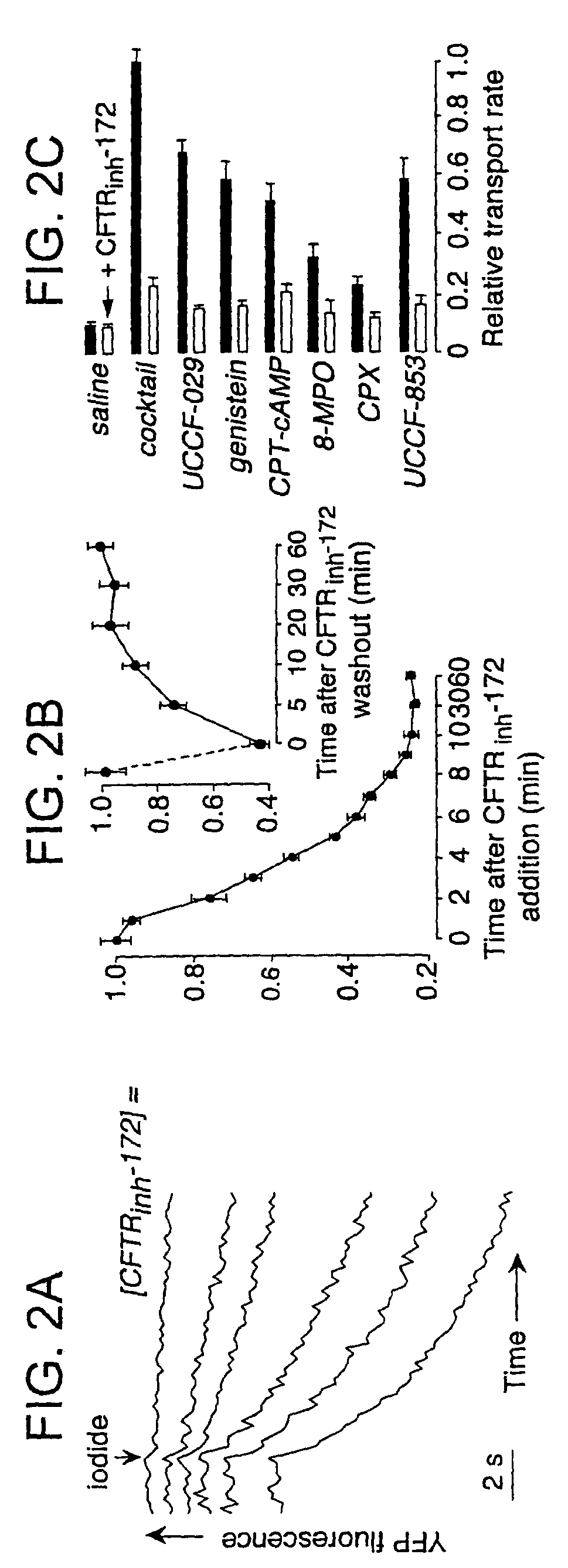Methods of treating secretory diarrhea using cystic fibrosis transmembrane conductance regulator protein inhibitors
a technology of transmembrane conductance regulator and inhibitor, which is applied in the direction of biocide, drug composition, animal husbandry, etc., can solve the problems of inadequacies of cf mouse models, little or no airway disease, morbidity and mortality, etc., and achieve the effect of inhibiting cftr
- Summary
- Abstract
- Description
- Claims
- Application Information
AI Technical Summary
Benefits of technology
Problems solved by technology
Method used
Image
Examples
biological example 1
Screening of CFTR Inhibitors
[0184]The primary screening technique used to identify the compounds of the invention was designed to identify inhibitors of CFTR Cl− conductance by direct CFTR-inhibitor interaction. CFTR was pre-stimulated in CFTR-expressing FRT cells by an activating cocktail containing forskolin, IBMX and apigenin, as shown schematically in FIG. 1A. The activation of CFTR by multiple mechanisms (cAMP elevation, phosphodiesterase inhibition, and direct CFTR binding) allowed identification of inhibitors that blocked the CFTR Cl− transporting pathway directly rather than more proximal step(s) in a signaling pathway. The FRT cells co-expressed a yellow fluorescent protein-based Cl31 / I− sensor that provided a quantitative fluorescence read-out of inhibition potency (See, e.g., Jayaraman et al., 2000, J. Biol. Chem. 275:6047-6050; Galietta et al., 2001, Am. J. Physiol. 281:C1734-C1742.). After CFTR pre-stimulation and compound addition, cells were subjected to an inwardly-...
biological example 2
Characterization of CFTRinh-172
[0188]The level of CFTR inhibition for specific dosages of the subject thiazolidinone compounds was determined using the fluorescence assay shown in FIG. 1A and described above. FIG. 2A shows dose-inhibition data for CFTRinh-172 as relative YFP fluorescence versus time. Significant CFTR inhibition was seen at 0.3-0.6 μM concentrations of this thiazolidinone compound. FIG. 2B shows that inhibition by CFTRinh-172 (shown graphically as relative transport rate versus time after addition or washout) was complete in ˜10 min (t1 / 2 4 min) and was reversed after washout with t1 / 2˜5 min (inset). The relative transport rates illustrated in FIG. 2C show that CFTRinh-172 effectively inhibited CFTR activation by multiple types of agonists that were not included in the activating cocktail used for initial screening. These agonists included genistein, CPT-cAMP, CPX, 8-MPO and the potent benzoflavone CFTR activator UCCF-029 (2-(4-pyridinium)benzo[h]4H-chromen-4-one bis...
biological example 3
[0196]The efficacy of CFTRinh-172 was tested in vivo using two assays of cholera toxin-induced intestinal fluid secretion, and in isolated intestine by short-circuit analysis. In the first assay, a series of closed loops of small intestine were created in vivo and the lumens of alternate loops were injected with small volumes of saline or saline containing cholera toxin. Luminal fluid accumulation was determined after 6 hours. As seen visually in FIG. 5A, there was marked fluid accumulation and distention in cholera toxin-treated loops, whereas adjacent control (saline) loops remained empty. A single administration of CFTRinh-172 (150 μg / kg intraperitoneal) prior to cholera toxin infusion effectively prevented fluid accumulation in the toxin-treated intestinal loops.
[0197]Data from a series of these experiments is summarized graphically in FIG. 5B. CFTRinh-172 significantly reduced fluid secretion to that in saline control loops where an inactive thiazolidinone analo...
PUM
| Property | Measurement | Unit |
|---|---|---|
| volume | aaaaa | aaaaa |
| concentration | aaaaa | aaaaa |
| 14C-radioactivity | aaaaa | aaaaa |
Abstract
Description
Claims
Application Information
 Login to View More
Login to View More - R&D
- Intellectual Property
- Life Sciences
- Materials
- Tech Scout
- Unparalleled Data Quality
- Higher Quality Content
- 60% Fewer Hallucinations
Browse by: Latest US Patents, China's latest patents, Technical Efficacy Thesaurus, Application Domain, Technology Topic, Popular Technical Reports.
© 2025 PatSnap. All rights reserved.Legal|Privacy policy|Modern Slavery Act Transparency Statement|Sitemap|About US| Contact US: help@patsnap.com



